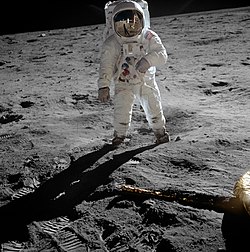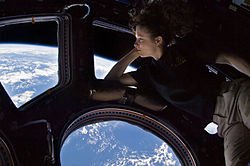Human spaceflight (also referred to as manned spaceflight or crewed spaceflight) is spaceflight with a crew or
passengers aboard a spacecraft, often with the spacecraft being operated directly by the onboard human
crew. Spacecraft can also be remotely operated from ground stations on Earth, or autonomously, without any
direct human involvement. People trained for spaceflight are called astronauts (American or other), cosmonauts
(Russian), or taikonauts (Chinese); and non-professionals are referred to as spaceflight
participants or spacefarers.
Human spaceflight

Cold War era
Human spaceflight capability was first developed during the Cold War between the United States and the Soviet
Union (USSR). These nations developed intercontinental ballistic missiles for the delivery of nuclear
weapons, producing rockets large enough to be adapted to carry the first artificial satellites into low
Earth
After the first satellites were launched in 1957 and 1958 by the Soviet Union, the US began work on Project
Mercury, with the aim of launching men into
The USSR was secretly pursuing the Vostok program to accomplish the same thing, and launched the first human
into space, the cosmonaut Yuri Gagarin. On 12 April 1961, Gagarin was launched aboard Vostok 1 on a Vostok
3KA rocket and completed a single orbit. On 5 May 1961, the US launched its first astronaut, Alan Shepard,
on a suborbital flight aboard Freedom 7 on a Mercury-Redstone rocket. Unlike Gagarin, Shepard manually
controlled his spacecraft's attitude.[4] On 20 February 1962, John Glenn became the first American in
orbit, aboard Friendship 7 on a Mercury-Atlas rocket. The USSR launched five more cosmonauts in Vostok capsules,
including the first woman in space.
Post-Apollo era
In 1969, Nixon appointed his vice president, Spiro Agnew, to head a Space Task Group to recommend follow-on
human spaceflight programs after Apollo. The group proposed an ambitious Space Transportation System based on a
reusable Space Shuttle, which consisted of a winged, internally fueled orbiter stage burning liquid hydrogen,
launched with a similar, but larger kerosene-fueled booster stage, each equipped with airbreathing jet engines
for powered return to a runway at the Kennedy Space Center launch site. Other components of the system included
a permanent, modular space station; reusable space tug; and nuclear interplanetary ferry, leading to a human
expedition to Mars as early as 1986 or as late as 2000, depending on the level of funding allocated. However,
Nixon knew the American political climate would not support congressional funding for such an ambition, and
killed proposals for all but the Shuttle, possibly to be followed by the space station. Plans for the Shuttle
were scaled back to reduce development risk, cost, and time, replacing the piloted fly-back booster with two
reusable solid rocket boosters, and the smaller orbiter would use an expendable external propellant tank to
feed its hydrogen-fueled main engines. The orbiter would have to make unpowered landings,
Space Shuttle orbiter, first crewed orbital spaceplane
In 1973, the US launched the Skylab sortie space station and inhabited it for 171 days with three crews ferried
aboard an Apollo spacecraft. During that time, President Richard Nixon and Soviet general secretary Leonid
Brezhnev were negotiating an easing of Cold War tensions known as détente. During the détente, they
negotiated the Apollo–Soyuz program, in which an Apollo spacecraft carrying a special docking adapter
module would rendezvous and dock with Soyuz 19 in 1975. The American and Russian crews shook hands in
space, but the purpose of the flight was purely symbolic
The two nations continued to compete rather than cooperate in space, as the US turned to developing the Space
Shuttle and planning the space station, which was dubbed Freedom. The USSR launched three Almaz military
sortie stations from 1973 to 1977, disguised as Salyuts. They followed Salyut with the development of Mir,
the first modular, semi-permanent space station, the construction of which took place from 1986 to 1996.
Mir orbited at an altitude of 354 kilometers (191 nautical miles), at an orbital inclination of 51.6°. It was
occupied for 4,592 days and made a controlled reentry in 2001.
US / Russian cooperation
The dissolution of the Soviet Union in 1991 brought an end to the Cold War and opened the door to true
cooperation between the US and Russia. The Soviet Soyuz and Mir programs were taken over by the Russian
Federal Space Agency, which became known as the Roscosmos State Corporation. The Shuttle-Mir Program
included American Space Shuttles visiting the Mir space station, Russian cosmonauts flying on the Shuttle,
and an American astronaut flying aboard a Soyuz spacecraft for long-duration expeditions aboard Mir.
In 1993, President Bill Clinton secured Russia's cooperation in converting the planned Space Station Freedom
into the International Space Station (ISS). Construction of the station began in 1998. The station orbits
at an altitude of 409 kilometers (221 nmi) and an orbital inclination of 51.65°. Several of the Space
Shuttle's 135 orbital flights were to help assemble, supply, and crew the ISS. Russia has built half of the
International Space Station and has continued its cooperation with the US.


